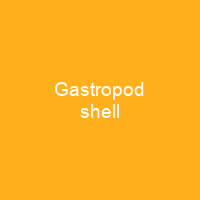
The Layers of Protection
Just like a well-built house has multiple layers for insulation and security, the gastropod shell is composed of three major layers. The calcareous central layer forms the bulk of the shell, providing structural support. Over this lies the periostracum, a thin outer layer that acts like a protective coating, much like paint on a house. Finally, there’s the smooth innermost layer, which is crucial for the proper formation and maintenance of the shell.
Morphology: A Blueprint for Survival
The gastropod shell’s morphology is not just an aesthetic choice but a survival strategy. The shape and structure are controlled by several factors, including the rate of growth per revolution around the coiling axis, the shape of the generating curve, and the rate of translation along this axis. These variables ensure that each species has a unique design tailored to its environment.
Some shells have irregularities or sculpturing features like ribs, spines, knobs, and varices. These additions serve various purposes—from providing additional protection against predators to reducing drag in water environments. The shell’s shape can even indicate the type of habitat it thrives in; wide-aperture shells are often found in high-energy environments, while high-spired forms prefer quieter waters.
Chirality: A Twist in Evolution
The chirality or handedness of gastropod shells is a fascinating aspect. The majority of species have dextral (right-handed) shells, but some are sinistral (left-handed), and others show mixed coiling patterns. This phenomenon has evolved independently 19 times among marine gastropods since the Cenozoic era. The gene NODAL plays a crucial role in determining chirality, with its expression correlating with asymmetric coiling.
While most authors depict shells with the apex of the spire uppermost for clarity, in life, these snails retract their soft parts and may use an operculum to close the aperture. The shell’s dimensions—height, width, height of the aperture, and number of whorls—are key indicators of its species and environment.
Shell Sculpture: Nature’s Artistry
The surface of a gastropod shell is not just smooth; it can be adorned with intricate patterns. Longitudinal ridges, transverse ribs, primary spirals, secondary spirals, and tertiary spirals are common features. Ribs extend from suture to suture, while spines may replace nodes or be irregularly located on the surface.
The aperture or peristome can have a simple structure with an outer and inner lip, or it can be modified with notches, emarginations, slits, holes, or bands. The outer emargination is often indicated by the reflected course of lines of growth on the shell. Inside, lirae (ridges) may be found next to the columella, while similar folds are present on the inner lip.
Aperture and Umbilicus: Key Features
The apertural end is the anterior end nearest to the head of the animal, often the posterior or dorsal side. The apex of the spire is usually uppermost in illustrations for clarity. In life, some gastropods use an operculum to close the aperture when retracted.
Dimensions such as height and width are crucial for identification. Evolutionary changes have seen mechanical stability, defense against predators, climatic selection, reduction or loss of shells in some species, and even a regain through heterochrony. For instance, in the Dinosaur Park Formation, fossil hadrosaur eggshells are rare due to acidic waters from tannins released by coniferous vegetation.
Fossilization: A Rare Gem
Fossilized gastropod shells are a precious find. The slow dissolution of these shells releases calcium carbonate into the water, raising pH levels high enough for eggshell fragments to be fossilized. This process is rare and occurs in only two microfossil sites predominated by preserved invertebrate life.
Further Reading and Resources
To delve deeper into the fascinating world of gastropod shells, consider exploring references like ‘Ease of fixation of a change in coiling: computer experiments on chirality in snails’ (van Batenburg et al.) and ‘Left-Right Asymmetry: More Than One Way to Coil a Shell’ (Wandelt & Nagy). For more detailed information, you can refer to K. Nair’s work or Antonio Ruiz Ruiz’s comprehensive guide on terrestrial gastropods of Andalucía.
From the simple spiral to the complex sculpting, gastropod shells are nature’s masterpiece. Each shell tells a story of survival and adaptation, making them not just beautiful but also invaluable in understanding evolutionary biology and environmental changes over time.
You want to know more about Gastropod shell?
This page is based on the article Gastropod shell published in Wikipedia (retrieved on November 25, 2024) and was automatically summarized using artificial intelligence.







